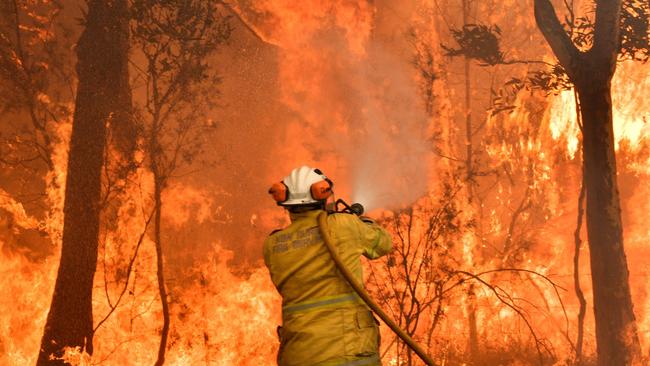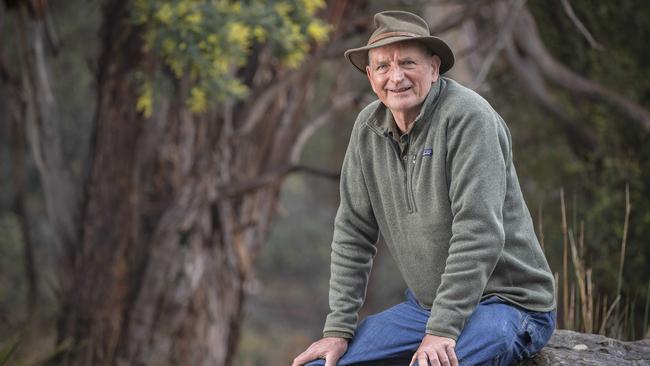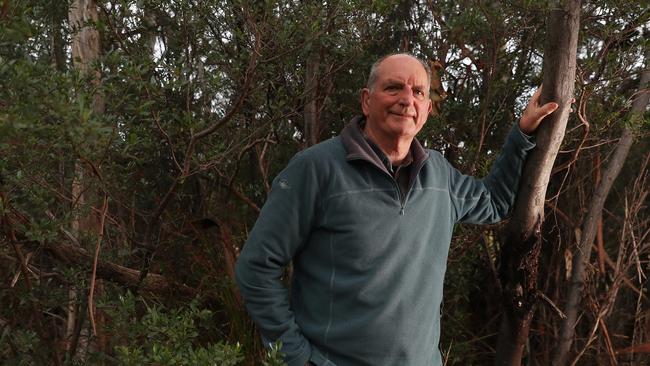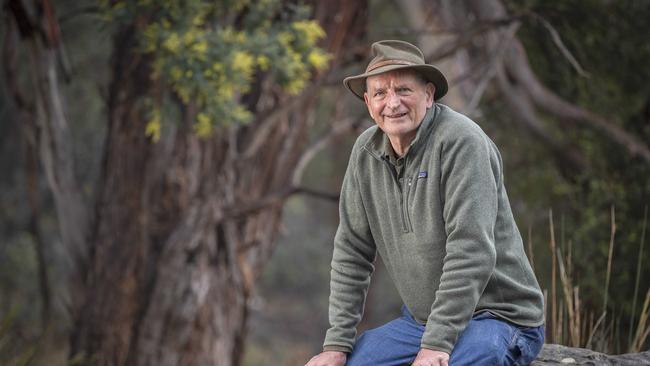Tasmanian fire scientist issues warning ahead of bushfire season
Tasmania’s leading fire expert admits he is “extremely afraid” of the summer to come. His plan to protect us >

News
Don't miss out on the headlines from News. Followed categories will be added to My News.
Tasmania should consider establishing a stand-alone bushfire management agency – and extending the traditional fuel reduction season, says Tasmania’s leading fire expert who admits he is “extremely afraid” of the summer to come.
The state’s run of unusually mild winter temperatures rolls on this week and with record temperatures and wildfires raging across the Northern Hemisphere, University of Tasmania Pyrogeography and Fire Science Professor David Bowman has called for “institutional reform”, extra government investment, and a wholesale change in attitude to help counter what is fast becoming the new normal.
“Everything is on the table,” Professor Bowman said.
“We are seeing, globally, a very unusual climate including sea surface temperatures, and wildfires.

“So anybody who is gripping to an historical baseline is not adapting. We need to be open to change.
“We need to develop a separate agency regarding fuel management, because it’s going to become so important. Fire fighting is quite different to fuel management.
“There needs to be a lot of engagement with communities and local government, because this is a shared responsibility.”
Following recent heatwaves in Europe and wildfire emergencies in Hawaii and Canada,
Professor Bowman sounded a warning for the coming fire season in Tasmania.
“I am extremely afraid for the coming summer,” he said.” We have had a lot of fuel growth and we are way ahead of schedule given it’s still winter.
“This summer is particularly concerning because we are so far advanced in terms of drying, and the fuel growth from wet summers.
“It’s part of the global fire crisis. What we are seeing is really extreme fire activity in flammable environments.

“Why does this worry me? It’s because Tasmania is a sitting duck. It’s just a matter of time now.”
Professor Bowman insisted that the traditional autumn fuel-reduction period start earlier and finish later, to take into account a rapidly changing climate.
He also said he was concerned that Tasmania was currently underprepared for the coming summer, urging residents to start working on bushfire plans now.
“The current weather is telling us that it could be a very hot summer. and a dangerous summer. “What I think we will be seeing is a lot more fuel reduction in winter, because it will be safer to do it then than autumn,” he said.
Professor Bowman said that while there were no quick fixes, stabilising the climate through decarbonisation was an urgent priority. He said there was a lot people could do to prepare for summer.
“I would urge everyone not to panic. It’s a great opportunity to start thinking about bushfires now because it’s not scary yet. But it will be scary when we get heatwaves.
“In other words, now is the time to be really careful thinking about fire plans, about your gardens, and where you are going to go. Even with whipper snippers and brush-cutters, we can do so much ahead of summer.”
Professor Bowman’s concerns come as a recent national survey reveals that than half (55 per cent) of Australians don’t know that rivers, creeks or roads cannot stop the path of a very intense bushfire, and just one in four don’t know that embers can travel up to 40km during a very intense bushfire.
The survey by Suncorp Insurance also found that 59 per cent of Tasmanians didn’t know the front of the fire was the most dangerous part, while 41 per cent didn’t know that lightning is one of the most common causes of bushfires in Australia.
Dante’s inferno: Tassie scientist’s grim bushfire warning
August 15: A horror bushfires season in the Northern Hemisphere is expected to hit Australian shores this summer, prompting a Tasmanian scientist to urge a major rethink in the strategy to tackle bigger and more extreme blazes.
UTAS Pyrogeography and Fire Science Professor David Bowman says the focus should be on prevention and government should follow Indigenous cultural burning practices to help mitigate the devastation of bushfires and its role in climate change.
Professor Bowman’s assessment forms part of new research published by the University of Tasmania and UNSW Canberra which assessed the global effects of Australia’s devastating Black Summer bushfire season in 2019-20.
The research highlights the urgent need for the world to better respond to extreme fires.
“For a long time, we have relied primarily on prescribed burning to reduce the fuel load for bushfires, but this is less effective in hotter and drier conditions, like those we will experience more frequently due to climate change,” Professor Bowman said.
“Add to that the fact we have an increasingly smaller window to complete prescribed burns and it’s clear we need a rethink.
“Following the Black Summer, policy discussions have focused on increasing firefighter capability and capacity, but with the extreme fires we expect in future no firefighting service could adequately respond to those. This means we need to get better at management and prevention.”

The area burned by Black Summer bushfires was 800 per cent larger than the average area burned in fires between 1988 and 2001. The fires released the equivalent of 80 per cent of Australia’s typical annual greenhouse gas emissions.
“In addition to prescribed burns, we must adopt the cultural burning practices used for centuries by First Nations Australians and determine to what extent they can be implemented at scale across the country,” Professor Bowman said.
“We should also consider what benefit marsupials and non-native herbivores can have on reducing the understorey vegetation across different parts of Australia. Thinning bushland surrounding urban areas and establishing ‘green fire breaks’ with irrigated, low flammable vegetation may also help to prevent the spread of fires.
“The fires we expect to face in future are going to be bigger and more dangerous than those we’ve experienced in the past, so we can’t just keep doing the same things to combat them.”
Fire generated thunderstorms, which were prevalent in Black Summer, also have the potential to drastically disrupt Earth systems according to UNSW Canberra Bushfire Dynamics Professor Jason Sharples.
“During the Black Summer we witnessed 44 fire thunderstorms, also called pyrocumulonimbus, where extreme fires alter the surrounding atmosphere,” he said.
“It shattered all previous records for a single fire season in Australia.”
“The unprecedented amount of smoke and greenhouse gases released by the fires also led to such immense stratospheric pollution that it damaged the ozone layer, caused a drop in sea temperatures and produced algal blooms that were larger in size than Australia in the Southern Ocean.”
Professor Sharples said if the community does not take action to mitigate the effects of climate change and improve fire management, the world will continue to see devastating climate events.
“We will be locked in a vicious cycle of climate change leading to larger fires and then those larger fires amplifying the effects of climate change,” he said.
tia.ewen@news.com.au




